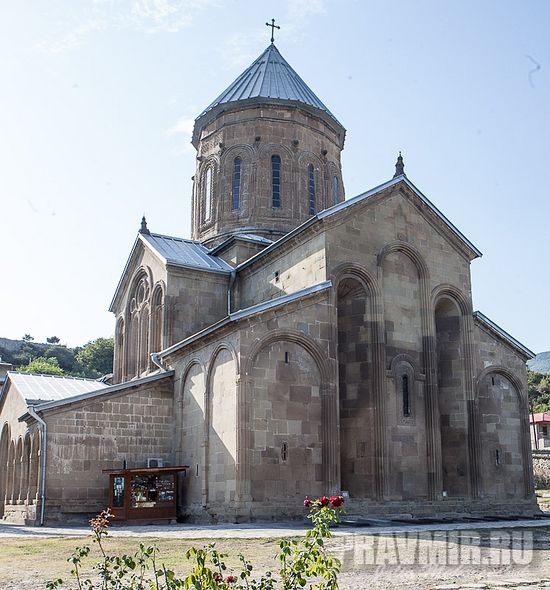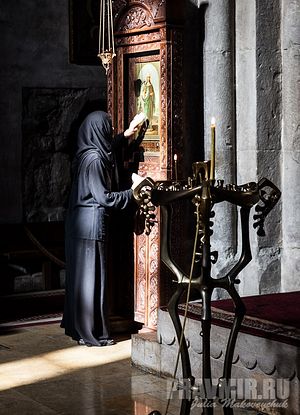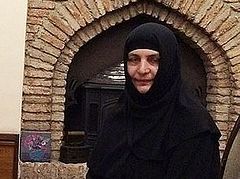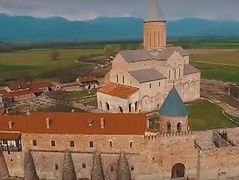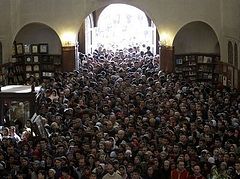The Samtavro Church of the Transfiguration and Convent of St. Nina is located at the confluence of the Mtkvari and Aragvi Rivers. The monastery is under the jurisdiction of the Catholicos-Patriarch of All Georgia and Archbishop of Mtskheta and Tbilisi Ilia II. In older sources, Mtskheta is called the Second Jerusalem.
The conversion of Georgia (Iberia) is closely connected with the Cappadocian virgin and Equal-to-the-Apostles St. Nina, who brought together the Georgian people and led them to God.
The blackberry bush where St. Nina preached Christianity, the light of which illumined all of Georgia, leading to Christianity being declared the state religion in 324 in the days of the holy King Mirian and Queen Nana, is located in this place.
The blackberry bush of St. Nina, as a source of spiritual grace, finds a counterpart in the Bible in Moses’s burning bush. In the words of His Holiness and Beatitude Patriarch Ilia of All Georgia: “St. Nina followed the Divine path of St. Andrew the First-Called and Simon the Canaanite, or the road of roads for every Georgian, that path is the Light of Christ.”
It is known that Samtravo was the center of Christian ecclesiastical life and spiritual labor throughout the centuries.
In the Georgian Chronicles, the sainted King Mirian says, “I built a church by this blackberry bush (meaning the small church in Makvlovani), and I built the upper church (Samtavro) for myself and the Georgian people, because the lower church (Svetitskhoveli) is called the Holy of Holies and I never dared to touch its holy doors.”
After St. Nina’s repose, the Equal-to-the-Apostles King Mirian, having returned from Bodbe, desired to build the Samtavro church: “The king and all the people went and built the upper church out of stone and finished it in the fourth year.” The participation “of all the people,” the desire of the king, and the four years of building are a sign that the church was quite large.
According to the testimony of Vakhushti Bagrationi,[1] “Mirian built a magnificent church with a stone dome and was himself buried there.” The Church of Samtavro became a sepulcher “and Mirian was buried to the south of the middle pillar, and in the fourth year Queen Nana died and was buried to the west of the same pillar where the king was buried.”
Due to the fact that the holy monastery became from the day of its foundation the burial place of the primates of the Church, it is called “Samtavro” [Meaning “principality” or “princedom.”—Trans.]. From the surviving chronicles, it is obvious that, thanks to large donations, the church was one of the richest in Georgia.
In the first half of the twelfth century, during the reign of George I, the church was expanded, the south gates were attached, and it was decorated with original ornamentation by decree of Catholicos Melchizedek. The church interior was also embellished.
After King Mirian, the Transfiguration Church was repeatedly destroyed and rebuilt. The church was restored under Kings Archil and Vakhtang Gorgasalis during the reign of Catholicos Melchizedek, etc.
In the second half of the nineteenth century, in the time of the exarchate, the church was renovated by the abbess of the St. Nina Monastery, Nino Amilakhvari. A church school for girls was also founded (a four-classroom primary school), which was later transferred to Tbilisi. According to Iakob Gogebashvili,[2] “In this monastery school, many Georgian women were given a true Christian upbringing, a good education, knowledge of a handicraft, and wonderful, cultivated parents—true mothers.”
Out of the multi-colored Samtavro complex, today is preserved the Transfiguration Church, the small Church of St. Nina (Makvlovani), the bell tower, the tower-fortress, a church iconostasis from the fifteenth century, and frescoes from the seventeenth century. In the south gate there is the Church of St. Michael the Archangel; in the north wing there are two churches; the eastern Church of St. John the Baptist, and the western Church of St. John Chrysostom. To the left of the main altar is a another altar, and to the right is the Church of Sts. Mirian and Nana.
The church is cross-shaped, framed by the original ornamentation, which is unique in Georgian architecture. The cylindrical tower was built in the eighteenth century, and the bell tower in the fifteenth to seventeenth centuries.
There are many sacred objects in Samtavro Church: part of the Life-Giving Pillar,[3] the wonderworking Iveron Icon of the Mother of God which reads “Holy Iveron Georgian Monastery 1919,” the wonderworking icon of St. Nina donated from St. Petersburg by King George XII to his grandchildren in 1870, the graves of the holy King Mirian and Queen Nana, the holy relics of St. Abibos of Nekresi under the holy altar table, the relics of St. Shio Mgvime, part of the stone from the grave of St. Nina from Bodbe, and others.

